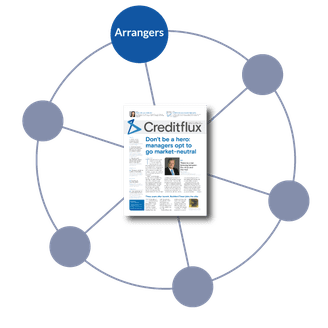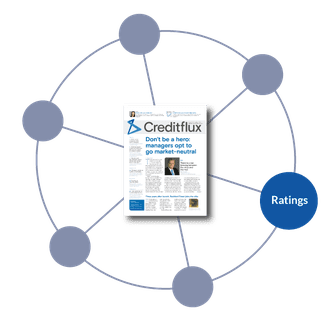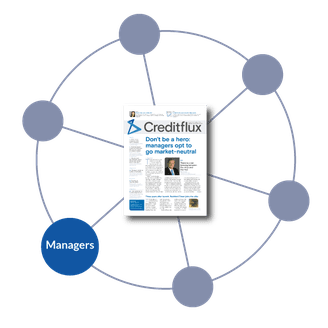


We invest where we have deep expertise
We invest where we have deep expertise
Scott Morrison, Head of Broadly Syndicated Loans at Golub Capital, offers his perspective on the BSL market and his outlook for investors in BSL securitizations.

“We believe we did well because our underwriting, monitoring and trading are designed to preserve par, especially during recessions and market dislocations”
Scott Morrison, Head of Broadly Syndicated Loans
Q.
The Covid-19 pandemic put investment managers to the test in 2020. Looking back, how did Golub Capital’s BSL strategy perform?A.
We believe our strategy performed very well through Covid. We’re proud to have been ranked #1 in market value change during the Covid-19 pandemic out of 103 managers tracked by Bank of America research1, and ranked #3 in par build by JP Morgan research2.
Our intense focus on credit quality has given us a 15+ year history of annual default rates averaging 80% below the BSL Index3 in aggregate. Our high conviction in our investments reflects the experience of our team; our team has an average of 23 years of credit experience.
When the BSL market sold off in March 2020, we didn’t panic. We’ve been through numerous downturns, both individually and as a team. This experience prepared us to stick to our fundamental convictions while focusing on building par and reducing risk through an active trading strategy.
Q.
What lessons have you taken away from the market volatility in 2020?A.
We think we were served well by being willing to disagree with the rating agencies. The Covid economic dislocation precipitated a rash of downgrades by the rating agencies. This was not surprising; there was a massive increase in uncertainty and ratings need to reflect this. But something else happened, too: we believe the rating agencies painted with a very broad brush. It was “downgrade first and ask questions later.” Managers of BSL securitizations that focus on smaller, sponsor-backed deals, as we do, saw many issuers of this type downgraded early in the Covid dislocation, leading to unusually high levels of CCC-rated assets in their CLOs. Managers in this position could have reduced their CCC exposure by selling CCC-rated assets, which would have meant crystallizing losses.
As an alternative, these managers could have chosen to “look bad” on CCC exposure metrics in the short term because they believed that those ratings did not accurately reflect credit risk. We chose to focus on our assessment of risk rather than rating agency assessments of risk, and we believe this approach enabled us to build par and perform well for our investors.
Q.
Where in today’s market do you see opportunity for investors in BSL securitizations?A.
We see a lot of signs of strength in the US economy. At the same time, we believe it’s prudent to stay cautious and not to compromise on credit quality. - Covid is defined as the period from February 2020 to December 2020 for the purposes of this analysis per Bank of America Research. Based on CLO managers covered in Bank of America Research’s “CLO Manager Performance: Hindsight is 2020” presentation as of January 13, 2021. Includes managers with more than one deal. Past performance does not guarantee future results.
- J.P. Morgan’s “US CLO Manager Analysis.” report as of January 27, 2021.
- The S&P/LSTA Leveraged Loan Index (the “BSL Index”) is a market value-weighted index designed to measure the performance of the US broadly syndicated loan market based upon market weightings, spreads and interest payments.
- Golub Capital BSL outperformed the BSL Index by 182 bps on an unlevered basis in 2020. Golub Capital BSL returns are based on the capital weighted average of monthly unlevered returns gross of fees and expenses of each Golub Capital managed Collateralized Loan Obligations (CLO) containing broadly syndicated loans. Golub Capital BSL returns are defined as (a) the total return of the underlying collateral in a given CLO, multiplied by (b) the size of the CLO and divided by (c) the aggregate size of applicable CLOs. The performance of the Golub Capital BSL composite does not represent the actual return of any investor or fund. The deduction of fees and expenses would lower actual returns. The BSL Index used in this analysis is the S&P/LSTA Leveraged Loan Index. The S&P/LSTA Leveraged Loan Index is a market value-weighted index designed to measure the performance of the U.S. broadly syndicated leveraged loan market. The S&P/LSTA Leveraged Loan Index typically encompasses 90%-95% of the entire broadly syndicated leveraged loan market. Past performance does not guarantee future results.
About Golub Capital
Golub Capital is a market-leading, award-winning direct lender and credit asset manager, with over $40 billion of capital under management.
Founded over 25 years ago, Golub Capital today has lending offices in Chicago, New York, San Francisco and London. For more information, please visit golubcapital.com.
September 2021 | Issue 238
Analysis
CLOs
2020 CLOs find sweet redemption

Charlie Dinning
Data journalist

Tanvi Gupta
Head of data journalism

Sam Robinson
Head of research
The believers have been vindicated: 2020 CLOs are among the best-performing of all time by IRR. Even those that have been reset are successful, with par flushes creating huge equity distributions
If there were any further questions about the resiliency of CLOs, perhaps the doubters should look at the group of CLOs with the all-time highest internal rate of return (IRR).
Of the top 20, nine priced in 2007 as the financial crisis was beginning, five priced last year as coronavirus wreaked havoc on the world and financial markets, and the highest IRR belongs to Jackson Square, which Blackstone Credit priced in 2009 while markets were in distress.
Nine 2020 US CLOs were redeemed this year after the market abandoned the traditional five-year reinvestment period and two-year non-call period for shorter profiles amid unprecedented volatility.
On average the IRR of the nine deals was 37.4%, with the highest returns belonging to RR 10, managed by Redding Ridge Asset Management (Apollo) and Stratus 2020-1, a static CLO from Blackstone Credit. They were redeemed with IRRs of 93.7% and 61.7%, respectively.
Palmer Square 2020-1 and Palmer Square Loan Funding 2020-3 are not yet fully redeemed, with both deals having at least one more payment to make, but these payments are predicted to push their IRRs up to 43.7% and 38.9%, respectively. Palmer Square CLO 2020-1 would stay in seventh place in the in the all-time IRR table and Palmer Square Loan Funding 2020-3 would be in ninth.
Cashing in: 2020 vintage deals redeemed in 2021 vs S&P/LSTA loan index

Source: S&P/LSTA Leveraged Loan Index
Palmer Square Loan Funding 2020-3 has a current IRR of 14.6%. The 2020-1 deal, which has returned a greater amount to equity investors (and is therefore included in the table) has an IRR of 42.3% at par and 67.9% using the original issue discount price (OID).
Most CLO managers had the added benefit of marking the equity tranches for 2020 deals at a discount, meaning the IRR at the equity tranche’s OID is higher. However, Redding Ridge opted to do the opposite on RR 9 and SCFF 1, issuing the equity above par.

“Projections beat new issue CLOs”
Joe Naggar, Head of structured products | GoldenTree
First movers bag cheap assets
As the first two managers to price deals after the CLO market closed for three weeks, Redding Ridge and Blackstone were able to ramp up the portfolios for their CLOs cheaply, say people familiar with the situation. The Blackstone-managed Stratus series were opportunistic and issued to buy loans that were heavily traded-off. In most cases, these loans were lower-spread assets that would not have been picked for a “Park” series CLO, so Blackstone adopted a new naming convention for these deals, sources say.
In last year’s heavily distressed market, CLO managers tried to capture a price arbitrage rather than the spread arbitrage they would aim for in normal times, according to sources. CLOs that priced in the early stages of the market coming back in April and May 2020 were able to ramp their portfolios in the low-90s. This gave managers the chance to call the deals when assets reached par.

* Aggregate purchase price was taken for the calculation
** Projected final IRR is 43.7%. Current figure 42.3%
Portfolio prices did not stay low for long. Stratus 2020-1, for example, was ramped at a price of around 92%, sources say. But the price had risen to almost 97% by June when it went effective and was up to 99.19% before the manager sold the portfolio.
Gulf Stream Asset Management and ArrowMark Partners were the other two US CLO managers to redeem 2020 CLOs. The managers priced Gulf Stream Meridian 2 and Apres Static 2 with the intention of calling them when liabilities had gapped in and assets had recovered, according to people familiar with the situation.
Meridian 2 and Apres Static 2 had equity tranches marked below par, with their IRRs coming in at 25.1% and 42.6%, respectively when using their OIDs. At par, Meridian 2 returned 9.2% and Apres Static 2, 5.9%.
The pull-to-par from CLO assets was a key factor in why 2020 deals redeemed this year had tremendous IRRs and one of the biggest reasons why some managers opted to redeem the CLOs, instead of resetting them like so many others.
* As per last trustee report before asset sell-off
*Deals are expected to make at least 1 more payment and brackets contain projected figures
** As per last trustee report before asset sell-off
† Redding Ridge (Apollo)
It is not just managers that have reaped the benefits of 2020 US CLO resets — equity investors have enjoyed par flush post-resets after portfolios in this short-dated vintage recovered sharply.
Market sources say that third-party equity investors would rather reset a transaction — and continue to receive cashflows in the future — than call a deal. This year there have been 42 2020 US CLO resets, compared to nine redemptions.
The highest post-reset par flush on a regular-way US CLO this year was on AIG 2020-1, as it paid 259% annualised in June to equity investors. Partners Group also achieved over 200% on Pikes Peak 6. GoldenTree US CLO 7, Octagon 47 and Ares LV all annualised over 100% on their post-reset payment dates.
93.7%
Final IRR of RR10 CLO, the second highest of all time
Joe Naggar, head of structured products and chair of the risk committee at GoldenTree says, regarding GoldenTree 7, that a reset was the best option as “the projected returns of the reset transaction were compelling relative to a new issue CLO at the time because of lower upfront costs”.
CBAM had the highest post-reset par flush of any 2020 US CLO on its unusual CLO, CBAM 2020-12. The deal packaged the CLO’s junior debt and much of the equity into one triple B-rated tranche, meaning its equity tranche was only $6 million in size. This resulted in leverage of 78.7 turns when it priced in July last year.
The manager reset the transaction in June and upsized the debt tranches by nearly $20 million and in turn increased its leverage to 81.3-times. After it was reset, CBAM 2020-12 paid over $25 million to the small equity tranche in July for an annualised figure of 1,682%. CBAM 2020-12 did not make any payments to the equity tranche on its two prior payment dates in January and April.
Methodology
- The data for this analysis consists of 2020 vintage US CLOs priced after March 2020 that have been either redeemed or reset in H1 2021.
- Multiples of money is calculated by dividing aggregate equity payments to date by the par and OID size of the subordinated notes, and in the case of an upsize, the new equity tranche amount.
- Portfolio change is the percent change between the CLO portfolio at its effective date and at the report date before asset sell-off. The figures are calculated based on loan tranches.
- Data is from CLO-i and Moody’s Analytics.
Share this article:
Global credit funds & CLO's
September 2021 | Issue 238
Published in London & New York.
Copyright Creditflux. All rights reserved. Check our Privacy Policy and our Terms of Use.






















